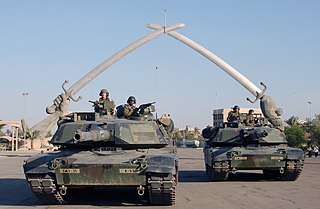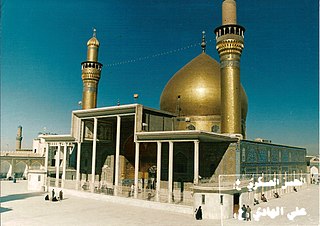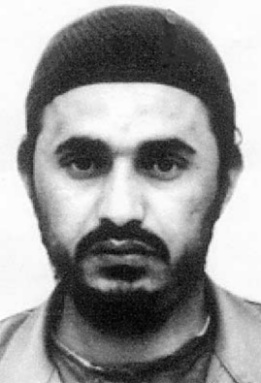Related Research Articles

The following is a timeline of major events during the Iraq War, following the 2003 invasion of Iraq.

Jama'at al-Tawhid wal-Jihad, abbreviated as JTJ or Jama'at, was a Salafi jihadist militant group. It was founded in Jordan in 1999, and was led by Jordanian national Abu Musab al-Zarqawi for the entirety of its existence. During the Iraqi insurgency (2003–11), the group became a decentralized network with foreign fighters with a considerable Iraqi membership.

An Iraqi insurgency began shortly after the 2003 American invasion deposed longtime leader Saddam Hussein. It is considered to have lasted until the end of the Iraq War and U.S. withdrawal in 2011. It was followed by a renewed insurgency.
Events in the year 2005 in Iraq.

Tal Afar is a city in the Nineveh Governorate of northwestern Iraq, located 63 km (39 mi) west of Mosul, 52 km (32 mi) east of Sinjar and 200 km (120 mi) northwest of Kirkuk. Its local inhabitants are exclusively Turkmen.

At approximately 6:44 a.m. Arabia Standard Time on 22 February 2006, al-Askari Shrine in Samarra, Iraq, was severely damaged in a bombing attack amidst the then-ongoing Iraq War. Constructed in the 10th century, it is one of the holiest sites in Shia Islam. Despite the magnitude of the explosions, there were no casualties. American president George W. Bush asserted that the bombing had been carried out by Al-Qaeda in Iraq, which denied involvement in the attack.
The following lists events that happened during 2006 in Iraq.

The Iraq War, also referred to as the Second Gulf War, was a prolonged conflict in Iraq lasting from 2003 to 2011. It began with the invasion by a United States-led coalition, which resulted in the overthrow of the Ba'athist government of Saddam Hussein. The conflict persisted as an insurgency arose against coalition forces and the newly established Iraqi government. US forces were officially withdrawn in 2011. In 2014, the US became re-engaged in Iraq, leading a new coalition under Combined Joint Task Force – Operation Inherent Resolve, as the conflict evolved into the ongoing insurgency.

Abu Musab al-Zarqawi, born Ahmad Fadeel Nazal al-Khalayleh, was a Jordanian militant jihadist who ran a training camp in Afghanistan. He became known after going to Iraq and being responsible for a series of bombings, beheadings, and attacks during the Iraq War, reportedly "turning an insurgency against US troops" in Iraq "into a Shia–Sunni civil war". He was sometimes known by his supporters as the "Sheikh of the slaughterers".
Events in the year 2007 in Iraq.
Chlorine bombings in Iraq began as early as October 2004, when insurgents in Al Anbar province started using chlorine gas in conjunction with conventional vehicle-borne explosive devices.

After the death of Muhammad in 632, the Muslim world split into two camps, the Sunnis, who believed that the caliphs of the Islamic community should be chosen by a council, and a second group, the Shia, who believed that Mohammed had named his successor to be Ali ibn Abi Talib, his cousin and son-in-law.
Al-Karmah, also sometimes transliterated as Karma, Karmah, or Garma, is a city in central Iraq, 16 km (10 mi) northeast of Fallujah in the province of Al Anbar.

Al-Qaeda in Iraq, was a Salafi jihadist organization affiliated with al-Qaeda. It was founded on 17 October 2004, and was led by Abu Musab al-Zarqawi until its disbandment on 15 October 2006 after he was killed in a targeted bombing on June 7, 2006 in Hibhib, Iraq by the United States Air Force.

The Anbar campaign consisted of fighting between the United States military, together with Iraqi security forces, and Sunni insurgents in the western Iraqi governorate of Al Anbar. The Iraq War lasted from 2003 to 2011, but the majority of the fighting and counterinsurgency campaign in Anbar took place between April 2004 and September 2007. Although the fighting initially featured heavy urban warfare primarily between insurgents and U.S. Marines, insurgents in later years focused on ambushing the American and Iraqi security forces with improvised explosive devices (IEDs), large scale attacks on combat outposts, and car bombings. Almost 9,000 Iraqis and 1,335 Americans were killed in the campaign, many in the Euphrates River Valley and the Sunni Triangle around the cities of Fallujah and Ramadi.

This list details terrorist incidents occurring in Iraq in 2007. In 2007, the US sent 20,000 additional troops into combat as part of a troop surge. There were 442 bombings in 2007, the second-most in a single year during the Iraq War. Major events included a January 16 attack on Mustansiriyah University, which killed 70 and injured 180, and February 3 bombings at the Sadriyah market in Baghdad, which killed 135 people.

The Islamic State of Iraq was a Salafi jihadist militant organization that fought the forces of the U.S.-led coalition during the Iraqi insurgency. The organization aimed to overthrow the Iraqi federal government and establish an Islamic state governed by Sharia law in Iraq.
Shia Muslims have been persecuted by the Islamic State (IS), an Islamist terrorist group, since 2014. Persecutions have taken place in Iraq, Syria, and other parts of the world.
On 7 July 2016, at least 56 people were killed and 75 injured after a group of attackers stormed the Mausoleum of Sayid Mohammed bin Ali al-Hadi, a Shia holy site in Balad, Iraq. The attackers included suicide car bombers, suicide bombers on foot, and several gunmen. They attacked Shia pilgrims celebrating Eid al-Fitr, which marks the end of the Muslim holy month of Ramadan. There were three suicide bombers, and one of them was killed by security personnel. There were other attackers too. ISIL also launched several mortars into the area.
References
- ↑ "'Chlorine bomb' hits Iraq village". BBC News. 16 May 2007. Retrieved 23 January 2008.
- 1 2 Black, Ian (17 May 2007). "Chlorine bomb blamed for up to 45 deaths in Iraqi Shia town". The Guardian. London. Retrieved 23 January 2008.